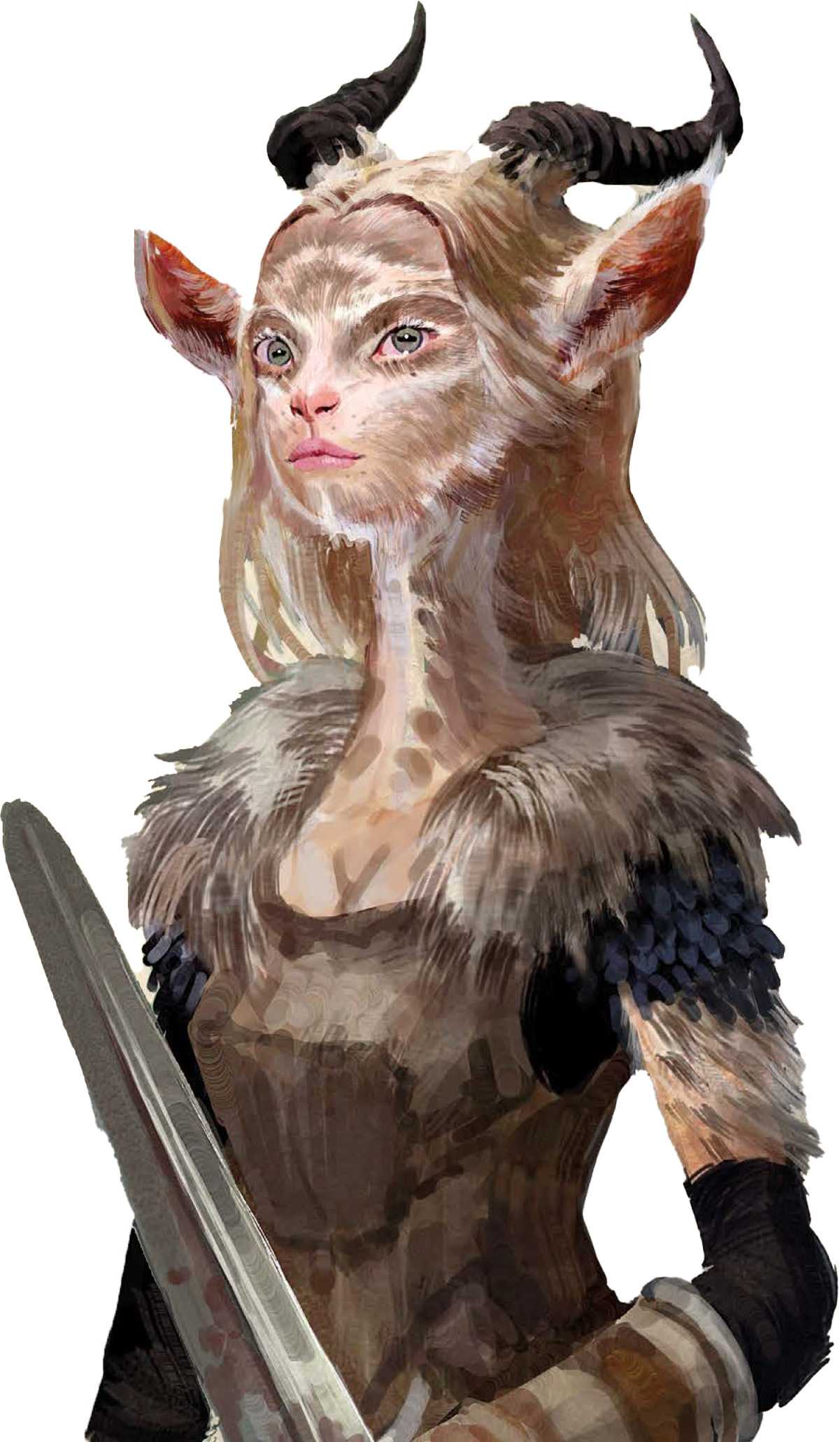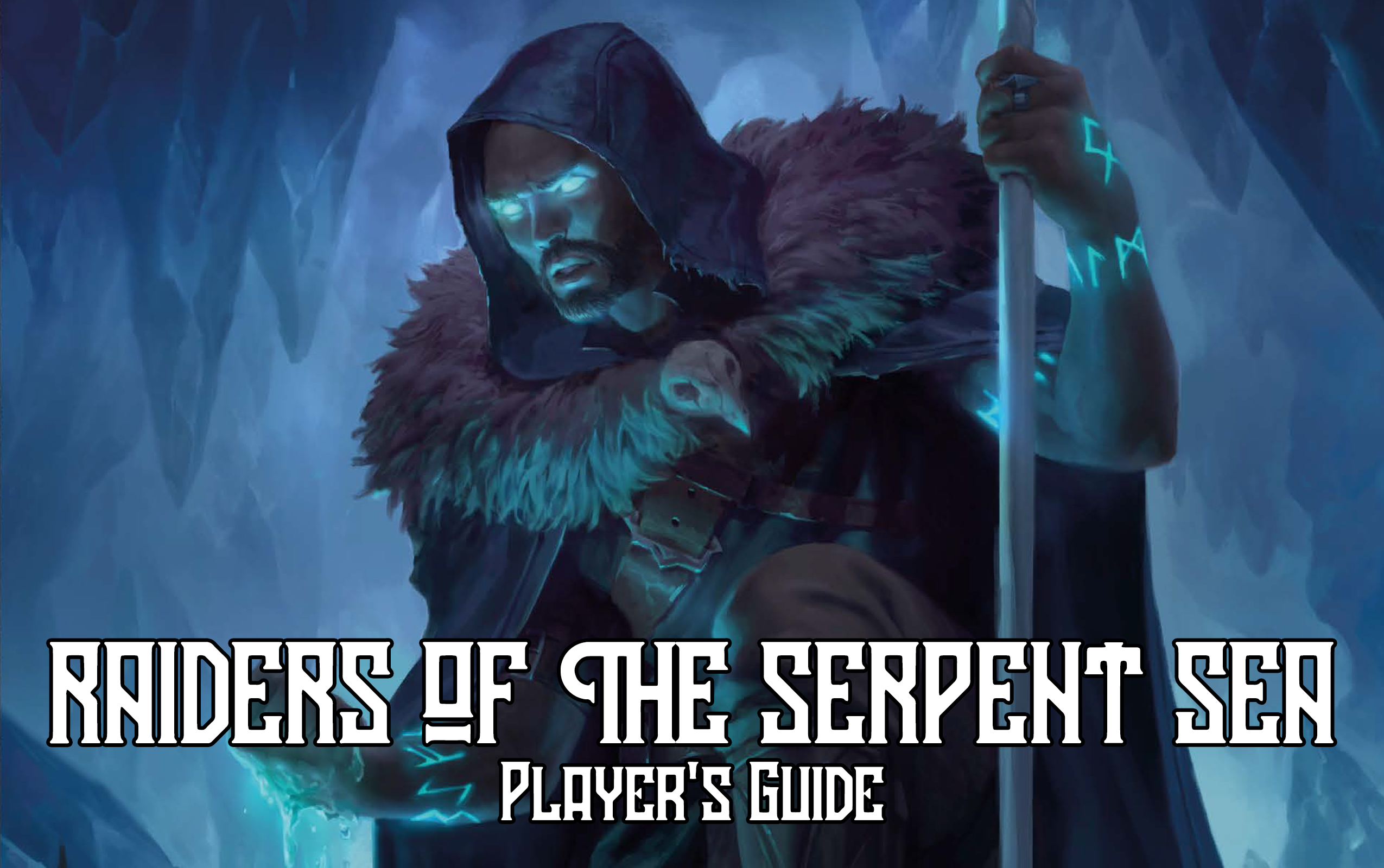Raiders of the Serpent Sea is a third-party campaign for D&D 5th Edition created by Brent Knowles, the lead designer of Dragon Age Origins, and released by Arcanum Worlds, who are also the publishers of Odyssey of the Dragonlords, Heroes of Baldur’s Gate, Minsc & Boo’s Journal of Villainy, and Chains of Asmodeus.
The campaign is set in a world inspired by Norse mythology, with the PCs as reavers seeking the immortality of glory in the shadow of a Ragnorak-esque apocalypse. When it hit Kickstarter I’d already been scoping out sea-based campaigns, and I’m always a sucker for Norse mythology, so it was nearly a no-brainer for me to back the five-hundred page mega-tome.
This, however, is not a review of the campaign book. It is, instead a review of the Player’s Guide that accompanies the campaign.
Personally, I’ve grown quite skeptical of player’s guides. In theory, the idea of a slim, slickly produced book that I could give to my players to get them amped up for an impending campaign sounds like a great idea. In practice, however, I’m almost always underwhelmed. The biggest problem tends to be that they’re cheaply produced by mostly copy-pasting text from the main book, which would be okay if it was properly rewritten for the players. But it frequently isn’t, resulting in a book that I can’t give to players without inundating them with spoilers that are better delivered during actual play. The result is a book with no utility at all.
It’s probably not surprising, therefore, that I skipped right past the Raiders of the Serpent Sea player’s guide and went directly to the main campaign book.
I quickly realized, however, that this was a mistake. The main campaign book kept referring to material from the Player’s Guide, and it quickly became apparent that this guide was, in fact, essential. Far from an afterthought, it had been designed as an integral part of the campaign.
So I set the campaign book aside and pulled out the Player’s Guide.
And I was deeply impressed by what I found.
THE WORLD OF GRIMNIR
The world of Grimnir was born from apocalypse: The Yoten had invaded the lands of the Vanir and, thanks to the betrayal of the mage-turned-god named Mirgal, had driven them to the verge of destruction. In the final battle, Aldyhn, the leader of the Vanir, slew Mirgal and performed a powerful rite which turned his blood and flesh and bone into the seeds of a new world. The Vanir fled into this new world, leaving the Yoten trapped behind.
The legacy of apocalypse, however, lies deep within the rock and waves of Grimnir, and now this world, too, is threatened with destruction.
As presented in this primer, I really like the world of Grimnir. It’s not just history with the numbers scratched off. Knowles has been legitimately inspired by myth and legend, and then built creatively from that inspiration to create something unique and fascinating.
For example, not all of the inhabitants of Grimnir crossed over from the old world. There are native peoples who were born with the world. Which raises a fascinating and fantastic dilemma: To whom does the world belong? Those who created it or those born to it? Both? Neither?
The gods, it should be noted, are not the Norse gods. Again, Knowles has taken inspiration, but created a legacy of fresh myth, redolent of Norse themes — of divine betrayals in a world born of betrayal; of a struggle against inevitable nihilism; of a warrior’s glory and doom — in new-minted wonder.
The major factions of Grimnir are the Raiders (i.e., your Viking heroes), the Baendur Kingdoms (young kingdoms ripe for raiding), and the Witches of the Ironwood (servants of a dark lord).
My only gripe with the presentation of Grimnir in the Player’s Guide is that the two-page map world map was printed with nearly all of the label layers turned off. I’m fairly certain this was a production error, but it makes the gazetteer and description of the world almost incoherent. If you’re giving the Player’s Guide to your players, I recommend also giving them a copy of the properly labeled world map from the full campaign book.
(To be honest, even with the labels turned on, there seem to be some inconsistencies between the map’s depiction of the world and the text. But it definitely helps.)
BACKGROUNDS
Raiders of the Serpent Sea includes several “epic backgrounds.” These backgrounds — the Bonded, the Cursed Raider, the Fallen, the Royal Heir, and the Vigilant One — are designed to be taken instead of the normal backgrounds from the Player’s Handbook.
What makes these epic backgrounds particularly notable is that they’ve been integrated into the campaign. While still giving the player a ton of freedom for customizing the details of their character, they provide a starting story connection, along with heroic tasks and epic goals seem to be designed so that they can potentially be achieved in several different ways during the campaign.
Now, I haven’t seen how the campaign actually executes on this concept from the other side, so I don’t know how well it actually pulls this off. But I like this A LOT.
I’ve talked before about how you should create characters who are integrated into the campaign, and also how published adventures are forced to feature generic hooks (since they don’t know your campaign or who your PCs are), but that you can super-charge your campaign by making the hooks specific to your group.
When you start talking about published campaigns, on the other hand — instead of modular scenarios — it seems odd that so many of them are still designed around the bland, generic hooks. The players will be creating characters for this specific campaign, right? So, unlike a modular adventure, a campaign book can absolutely give you and your players guidance on creating characters who will be deeply tied to the campaign.
So it’s very exciting to see Raiders of the Serpent Sea do this in a robust and interactive way.
PLAYABLE RACES
Raiders of the Serpent Sea includes several new playable races.
Beastborn are literally animals who see a humanoid community, become enamored of their lives, and become human themselves in order to experience the lives they see. The book includes  guidelines for customizing your own beastborn based on any animal, along with prebuilt options for hunter-gatherers, fish, and fowl.
guidelines for customizing your own beastborn based on any animal, along with prebuilt options for hunter-gatherers, fish, and fowl.
Grims can sort of be thought of as merpeople, but with a distinctly Norse flavor to them. Importantly, they are the native children of Grimnir, their souls touched by the dead demigod who gave their world existence.
Tallfolk are small giants, their origins shrouded in mystery. They are always found as babes on the edges of the forests near Turnfjall, but none are certain who their parents are or why they are abandoned to become foundlings.
Tuss have the blood of the hated Yoten flowing through their veins. They can live their lives as humans — many are not even aware of their secret birthright — but in times of great stress or need, their Yoten blood may reveal itself.
Wicker are tree-golems, created to serve some ancient purpose which has been long-forgotten, even by themselves.
I really like all of these options. I’m probably not doing a great job of capturing the flavor, history, and unique identity that drips off the page here.
In fact, although the book assumes that you’ll be including the standard array of D&D races, I would be strongly tempted to ditch all of that while running Raiders of the Serpent Sea and use only humans and the original races presented here.
CLASS ARCHETYPES
The last big chunk of the Player’s Guide are twelve class archetypes, one for each of the core classes in the Player’s Handbook.
I haven’t personally playtested any of these archetypes, so I can’t be entirely certain how they work in actual play. But, reading through them, I really like that the design seems to be willing to take some BIG swings, which particularly manifests in a willingness to embrace bold, exciting flavor even if it can’t necessarily be nailed down to a convenient, combat-optimized mechanical package.
So you end up with a monk who is the chosen Wanderer, positioned by Fate at the fulcrum of reality. A wolf-riding ranger. Rogues who choose worship the dead god from whose bones the world was forged. Sorcerers who become disconnected from reality, believing that either they or the entire world is an illusion.
And so forth. Just grand, daring concepts that capture the imagination and are backed up with clever unique class abilities.
CONCLUSION
The rest of the Player’s Guide is fleshed out with a medley of interesting stuff:
- New spells;
- Ships for the PCs to own (although the actual ship rules appear to be in the campaign book);
- A one-page primer of the world for quickly introducing players who don’t want to read the full guide;
- Equipment;
- Mechanics for oaths, curses, and glory.
A surprisingly rich treasure trove for a slim, 80-page volume.
Ultimately, the Raiders of the Serpent Sea Player’s Guide turned me from a skeptic into a believer. It got me excited to read the full campaign, I’m certain it will get players amped up to actually play in the campaign, and it’s easy to imagine it being an erstwhile companion at the table for the duration of the campaign.
GRADE: B+
Designer: Brent Knowles
Additional Writing: Gage Ford, Atlantis Fraess, Carter Knowles, Linden Knowles, Brandon Korolik, Zack Webb
Publisher: Arcanum Worlds
Cost: $8.00 (PDF)
Page Count: 80













This parallels my experience. Looking forward to your review of the actual campaign, Mr. Alexander, especially the raiding structure in Appendix A.
Also, did you have any trouble finding the GMs Reference Guide? That thing gave me fits.
any plans on reviewing the whole thing? i’d be very interested in reading that
@Sparky: Is that in the GM Screen? I haven’t opened that yet. I have the advantage of having backed the Kickstarter, so everything just got sent to me in a bundle.
@lawrence: Very likely. Need to actually read the beast, though. 😉
@Justin Alexander
Hilariously, no sir. The Reference Guide is 32 pages long, and not included in the downloads from DriveThruRPG.com (or wasn’t, per my last review of the document). It contains the inspirational media, potential content warnings, customizing backgrounds, modifying difficulty for party size, etc. It’s kind of important!
It’s freely available on their website, but the omission of it from an already 500 page long book was a head-scratcher.